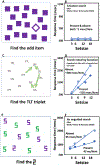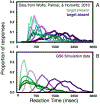Guided Search 6.0: An updated model of visual search
- PMID: 33547630
- PMCID: PMC8965574
- DOI: 10.3758/s13423-020-01859-9
Guided Search 6.0: An updated model of visual search
Abstract
This paper describes Guided Search 6.0 (GS6), a revised model of visual search. When we encounter a scene, we can see something everywhere. However, we cannot recognize more than a few items at a time. Attention is used to select items so that their features can be "bound" into recognizable objects. Attention is "guided" so that items can be processed in an intelligent order. In GS6, this guidance comes from five sources of preattentive information: (1) top-down and (2) bottom-up feature guidance, (3) prior history (e.g., priming), (4) reward, and (5) scene syntax and semantics. These sources are combined into a spatial "priority map," a dynamic attentional landscape that evolves over the course of search. Selective attention is guided to the most active location in the priority map approximately 20 times per second. Guidance will not be uniform across the visual field. It will favor items near the point of fixation. Three types of functional visual field (FVFs) describe the nature of these foveal biases. There is a resolution FVF, an FVF governing exploratory eye movements, and an FVF governing covert deployments of attention. To be identified as targets or rejected as distractors, items must be compared to target templates held in memory. The binding and recognition of an attended object is modeled as a diffusion process taking > 150 ms/item. Since selection occurs more frequently than that, it follows that multiple items are undergoing recognition at the same time, though asynchronously, making GS6 a hybrid of serial and parallel processes. In GS6, if a target is not found, search terminates when an accumulating quitting signal reaches a threshold. Setting of that threshold is adaptive, allowing feedback about performance to shape subsequent searches. Simulation shows that the combination of asynchronous diffusion and a quitting signal can produce the basic patterns of response time and error data from a range of search experiments.
Keywords: Attention; Bottom-up; Errors; Guided search; Reaction time; Selective attention; Top-down; Visual search; Visual working memory.
© 2021. The Psychonomic Society, Inc.
Figures















References
-
- Ball KK, Beard BL, Roenker DL, Miller RL, & Griggs DS (1988). Age and visual search: expanding the useful field of view. J. Optical Society of America - A, 5(12), 2210–2219. - PubMed
Publication types
MeSH terms
Grants and funding
LinkOut - more resources
Full Text Sources
Other Literature Sources

